The Antimicrobial Mode of Action of Maltol and Its Synergistic Efficacy with Selected Cationic Surfactants
Abstract
:1. Introduction
2. Materials and Methods
2.1. Minimum Inhibitory Concentration (MIC) and Checkerboard Assay
2.2. Potassium Leakage Assay
2.3. Transmission Electron Microscopy
2.4. Scanning Electron Microscopy
2.5. FICI Synergy Model
2.6. Challenge Test
2.7. Statistical Analysis
3. Results
3.1. MIC and Checkerboard Assays
3.2. Potassium Leakage
3.3. Transmission Electron Microscopy (TEM)
4. Discussion
5. Conclusions
Supplementary Materials
Author Contributions
Funding
Institutional Review Board Statement
Informed Consent Statement
Acknowledgments
Conflicts of Interest
References
- Han, Y.; Xu, Q.; Hu, J.N.; Han, X.Y.; Li, W.; Zhao, L.C. Maltol, a food flavoring agent, attenuates acute alcohol-induced oxidative damage in mice. Nutrients 2015, 7, 682–696. [Google Scholar] [CrossRef]
- Tiefel, P.; Berger, R.G. Seasonal variation of the concentrations of maltol and maltol glucoside in leaves of Cercidiphyllum japonicum. J. Sci. Food Agric. 1993, 63, 59–61. [Google Scholar] [CrossRef]
- Mar, A.; Pripdeevech, P. Chemical composition and antibacterial activity of essential oil and extracts of Citharexylum spinosum flowers from Thailand. Nat. Prod. Commun. 2014, 9, 707–710. [Google Scholar] [CrossRef] [Green Version]
- Hayata, Y. Studies on Passiflora incarnata dry extract. I. Isolation of maltol and pharmacological action of maltol and ethyl maltol. Chem. Pharm. Bull. 1974, 22, 1008–1013. [Google Scholar]
- Kornsakulkarn, J.; Saepua, S.; Supothina, S.; Chanthaket, R.; Thongpanchang, C. Sporaridin and sporazepin from actinomycete Streptosporangium sp. BCC 24625. Phytochem. Lett. 2014, 10, 149–151. [Google Scholar] [CrossRef]
- Zarrini, J. Introducing acidophilic and acid tolerant actinobacteria as new sources of antimicrobial agents against Helicobacter pylori. Arch. Razi Inst. 2021, 76, 1–23. [Google Scholar] [CrossRef]
- Rajamanikyam, M.; Gade, S.; Vadlapudi, V.; Parvathaneni, S.P.; Koude, D.; Kumar Dommati, A.; Kumar Tiwari, A.; Misra, S.; Sripadi, P.; Amanchy, R.; et al. Biophysical and biochemical characterization of active secondary metabolites from Aspergillus allahabadii. Process Biochem. 2017, 56, 45–56. [Google Scholar] [CrossRef]
- Kontoghiorghe, C.N.; Kolnagou, A.; Kontoghiorghes, G.J. Phytochelators intended for clinical use in iron overload, other diseases of iron imbalance and free radical pathology. Molecules 2015, 20, 20841–20872. [Google Scholar] [CrossRef] [Green Version]
- Kelsey, S.M.; Hider, R.C.; Bloor, J.R.; Blake, D.R.; Gutteridge, C.N.; Newland, A.C. Absorption of Low and Therapeutic Doses of Ferric Maltol, a Novel Ferric Iron Compound, in Iron Deficient Subjects Using a Single Dose Iron Absorption Test. J. Clin. Pharm. Ther. 1991, 16, 117–122. [Google Scholar] [CrossRef]
- Gasche, C.; Ahmad, T.; Tulassay, Z.; Baumgart, D.C.; Bokemeyer, B.; Büning, C.; Howaldt, S.; Stallmach, A. Ferric maltol is effective in correcting iron deficiency anemia in patients with inflammatory bowel disease: Results from a phase-3 clinical trial program. Inflamm. Bowel Dis. 2015, 21, 579–588. [Google Scholar] [CrossRef] [Green Version]
- Kaneko, N.; Yasui, H.; Takada, J.; Suzuki, K.; Sakurai, H. Orally administrated aluminum-maltolate complex enhances oxidative stress in the organs of mice. J. Inorg. Biochem. 2004, 98, 2022–2031. [Google Scholar] [CrossRef]
- Bernstein, L.R.; Tanner, T.; Godfrey, C.; Noll, B. Chemistry and pharmacokinetics of gallium maltolate, a compound with high oral gallium bioavailability. Met.-Based Drugs 2000, 7, 33–47. [Google Scholar] [CrossRef] [Green Version]
- Mi, X.J.; Hou, J.G.; Jiang, S.; Liu, Z.; Tang, S.; Liu, X.X.; Wang, Y.P.; Chen, C.; Wang, Z.; Li, W. Maltol Mitigates Thioacetamide-induced Liver Fibrosis through TGF-β1-mediated Activation of PI3K/Akt Signaling Pathway. J. Agric. Food Chem. 2019, 67, 1392–1401. [Google Scholar] [CrossRef]
- Li, W.; Su, X.M.; Han, Y.; Xu, Q.; Zhang, J.; Wang, Z.; Wang, Y.P. Maltol, a Maillard reaction product, exerts anti-tumor efficacy in H22 tumor-bearing mice via improving immune function and inducing apoptosis. RSC Adv. 2015, 5, 101850–101859. [Google Scholar] [CrossRef]
- Yasumoto, E.; Nakano, K.; Nakayachi, T.; Morshed, S.R.M.; Hashimoto, K.; Kikuchi, H.; Nishikawa, H.; Kawase, M.; Sakagami, H. Cytotoxic Activity of Deferiprone, Maltol and Related Hydroxyketones against Human Tumor Cell Lines. Anticancer Res. 2004, 24, 755–762. [Google Scholar] [PubMed]
- Jo, B.G.; Park, N.J.; Kim, S.N.; Jegal, J.; Choi, S.; Lee, S.W.; Yi, L.W.; Lee, S.R.; Kim, K.H.; Yang, M.H. Isolation of maltol derivatives from Stellera chamaejasme and the anti-atopic properties of maltol on skin lesions in DNCB-stimulated mice. RSC Adv. 2019, 9, 2125–2132. [Google Scholar] [CrossRef] [Green Version]
- Williams, M.; Eveleigh, E.; Forbes, G.; Lamb, R.; Roscoe, L.; Silk, P. Evidence of a direct chemical plant defense role for maltol against spruce budworm. Entomol. Exp. Appl. 2019, 167, 755–762. [Google Scholar] [CrossRef]
- Regulation (EC) No 1334/2008 of the European Parliament and of the Council of 16 December 2008 on flavourings and certain food ingredients with flavouring properties for use in and on foods and amending Council Regulation (EEC) No 1601/91, Regulations (EC) No 2232/96 and (EC) No 110/2008 and Directive 2000/13/EC (Text with EEA relevance). Off. J. Eur. Union 2018, 2016, 48–119.
- Schved, F.; Pierson, M.D.; Juven, B.J. Sensitization of Escherichia coli to nisin by maltol and ethyl maltol. Lett. Appl. Microbiol. 1996, 22, 189–191. [Google Scholar] [CrossRef] [PubMed]
- Salama, P.; Gliksberg, A. The use of catalytic amounts of selected cationic surfactants in the design of new synergistic preservative solutions. Cosmetics 2021, 8, 54. [Google Scholar] [CrossRef]
- Jay, J.M.; Rivers, G.M. Antimicrobial Activity of Some Food Flavoring Compounds. J. Food Saf. 1984, 6, 129–139. [Google Scholar] [CrossRef]
- Odds, F.C. Synergy, antagonism, and what the chequerboard puts between them. J. Antimicrob. Chemother. 2003, 52, 1. [Google Scholar] [CrossRef]
- Ziklo, N.; Tzafrir, I.; Shulkin, R.; Salama, P. Salicylate UV-filters in sunscreen formulations compromise the preservative system efficacy against Pseudomonas aeruginosa and Burkholderia cepacia. Cosmetics 2020, 7, 63. [Google Scholar] [CrossRef]
- Falk, N.A. Surfactants as Antimicrobials: A Brief Overview of Microbial Interfacial Chemistry and Surfactant Antimicrobial Activity. J. Surfactants Deterg. 2019, 22, 1119–1127. [Google Scholar] [CrossRef]
- Dolezal, R.; Soukup, O.; Malinak, D.; Savedra, R.M.L.; Marek, J.; Dolezalova, M.; Pasdiorova, M.; Salajkova, S.; Korabecny, J.; Honegr, J.; et al. Towards understanding the mechanism of action of antibacterial N-alkyl-3-hydroxypyridinium salts: Biological activities, molecular modeling and QSAR studies. Eur. J. Med. Chem. 2016, 121, 699–711. [Google Scholar] [CrossRef]
- Gilbert, P.; Moore, L.E. Cationic antiseptics: Diversity of action under a common epithet. J. Appl. Microbiol. 2005, 99, 703–715. [Google Scholar] [CrossRef] [PubMed]
- Yoshimatsu, T.; Hiyama, K.I. Mechanism of the action of didecyldimethylammonium chloride (DDAC) against Escherichia coli and morphological changes of the cells. Biocontrol Sci. 2007, 12, 93–99. [Google Scholar] [CrossRef] [PubMed] [Green Version]
- Saito, H.; Sakakibara, Y.; Sakata, A.; Kurashige, R.; Murakami, D.; Kageshima, H.; Saito, A.; Miyazaki, Y. Antibacterial activity of lysozyme-chitosan oligosaccharide conjugates (LYZOX) against Pseudomonas aeruginosa, Acinetobacter baumannii and Methicillin-resistant Staphylococcus aureus. PLoS One 2019, 14, e0217504. [Google Scholar] [CrossRef]
- Atay, H.Y. Antibacterial Activity of Chitosan-Based Systems. In Functional Chitosan; Jana, S., Jana., S., Eds.; Springer Nature Singapore Pte Ltd.: Singapore, 2019; ISBN 9789811502637. [Google Scholar]
- Clifton, L.A.; Skoda, M.W.A.; Le Brun, A.P.; Ciesielski, F.; Kuzmenko, I.; Holt, S.A.; Lakey, J.H. Effect of divalent cation removal on the structure of gram-negative bacterial outer membrane models. Langmuir 2015, 31, 404–412. [Google Scholar] [CrossRef] [Green Version]
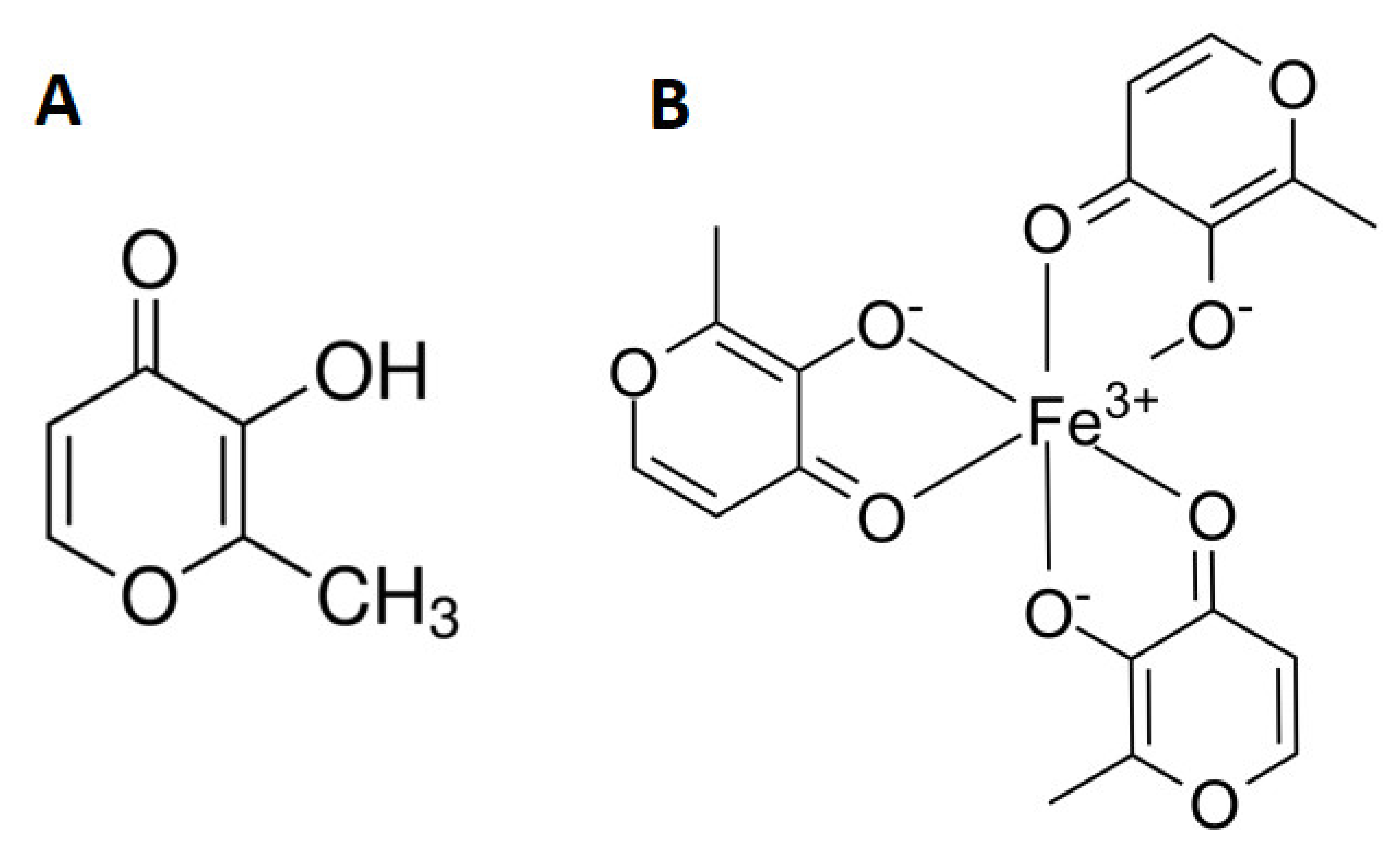
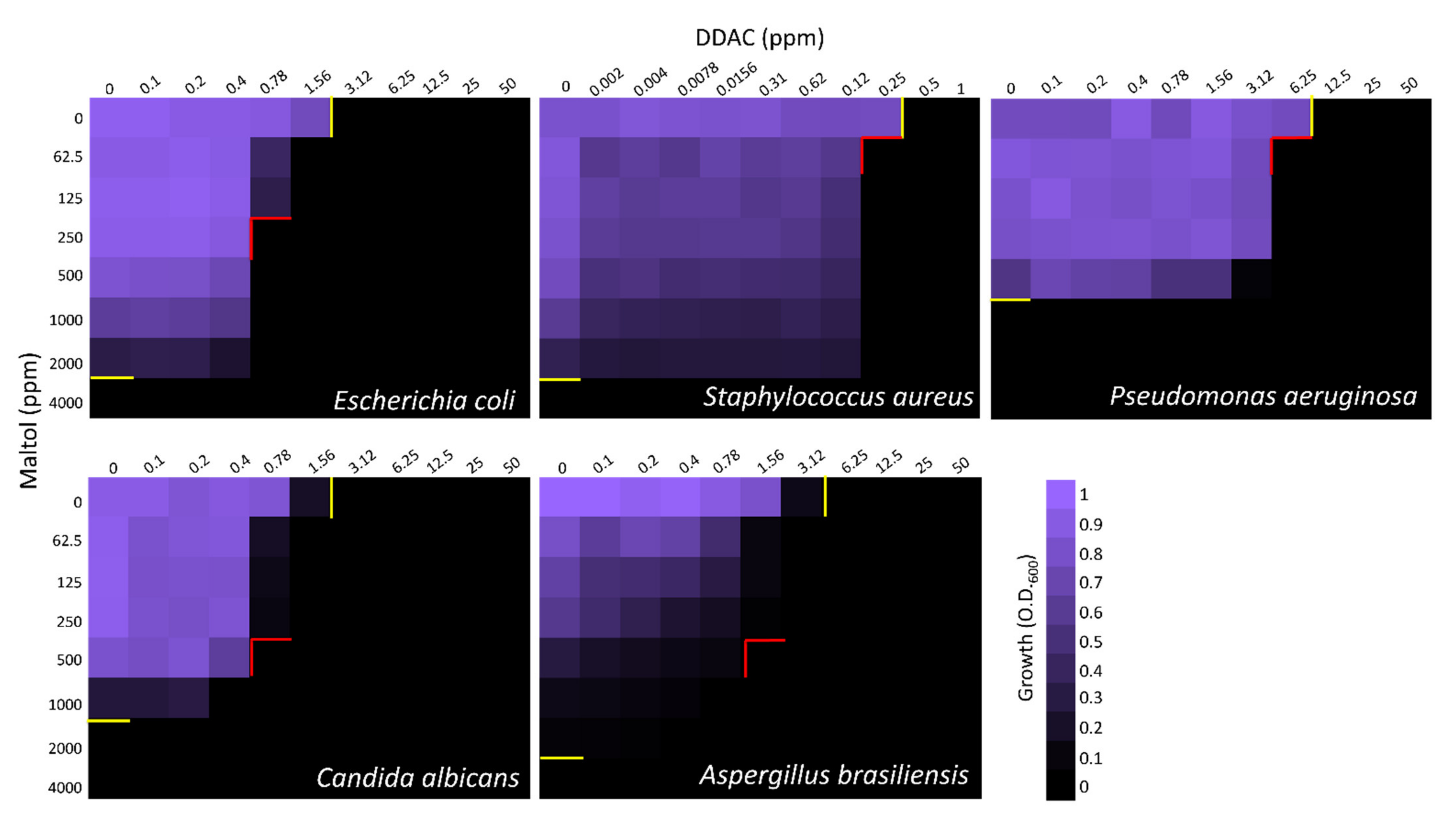
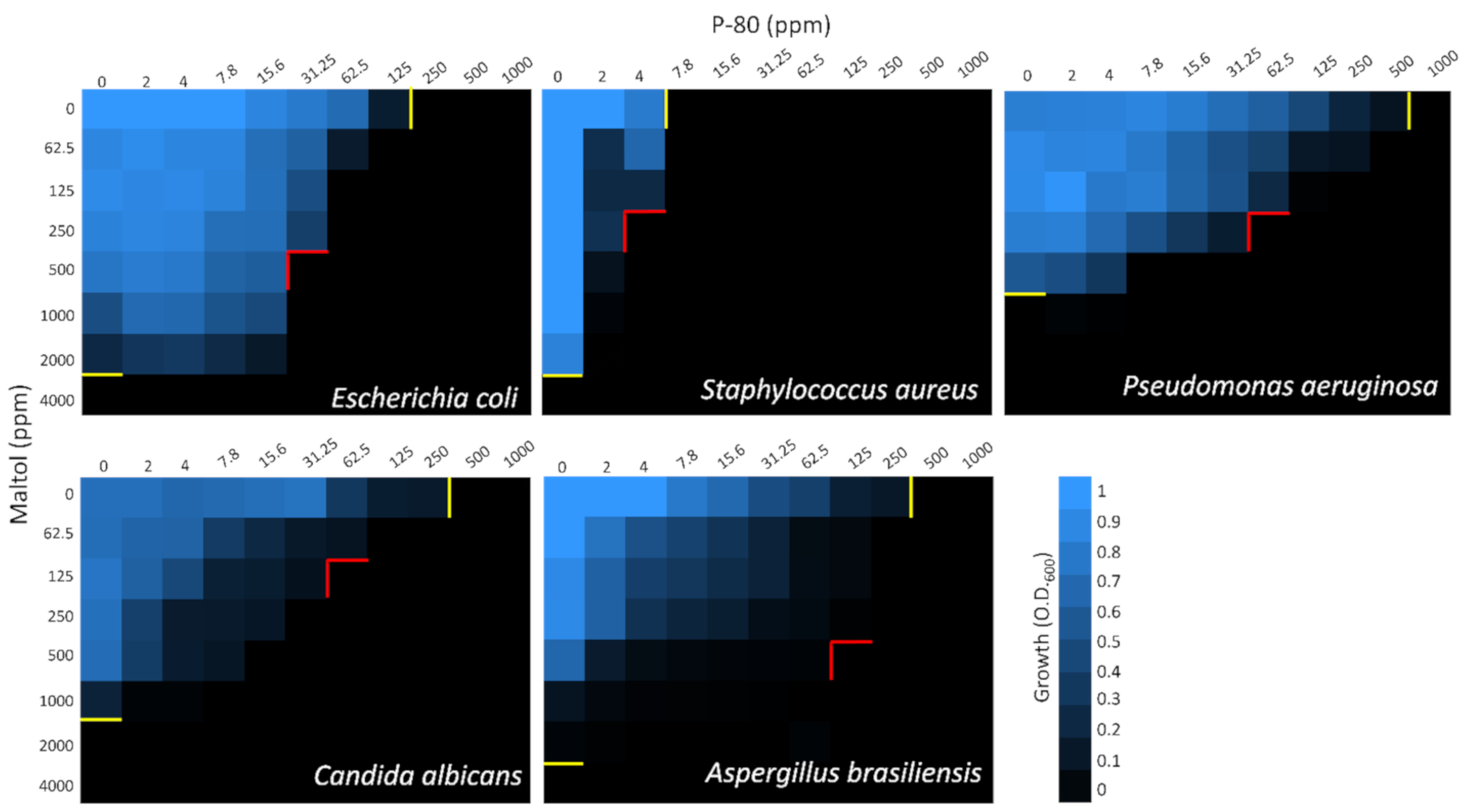
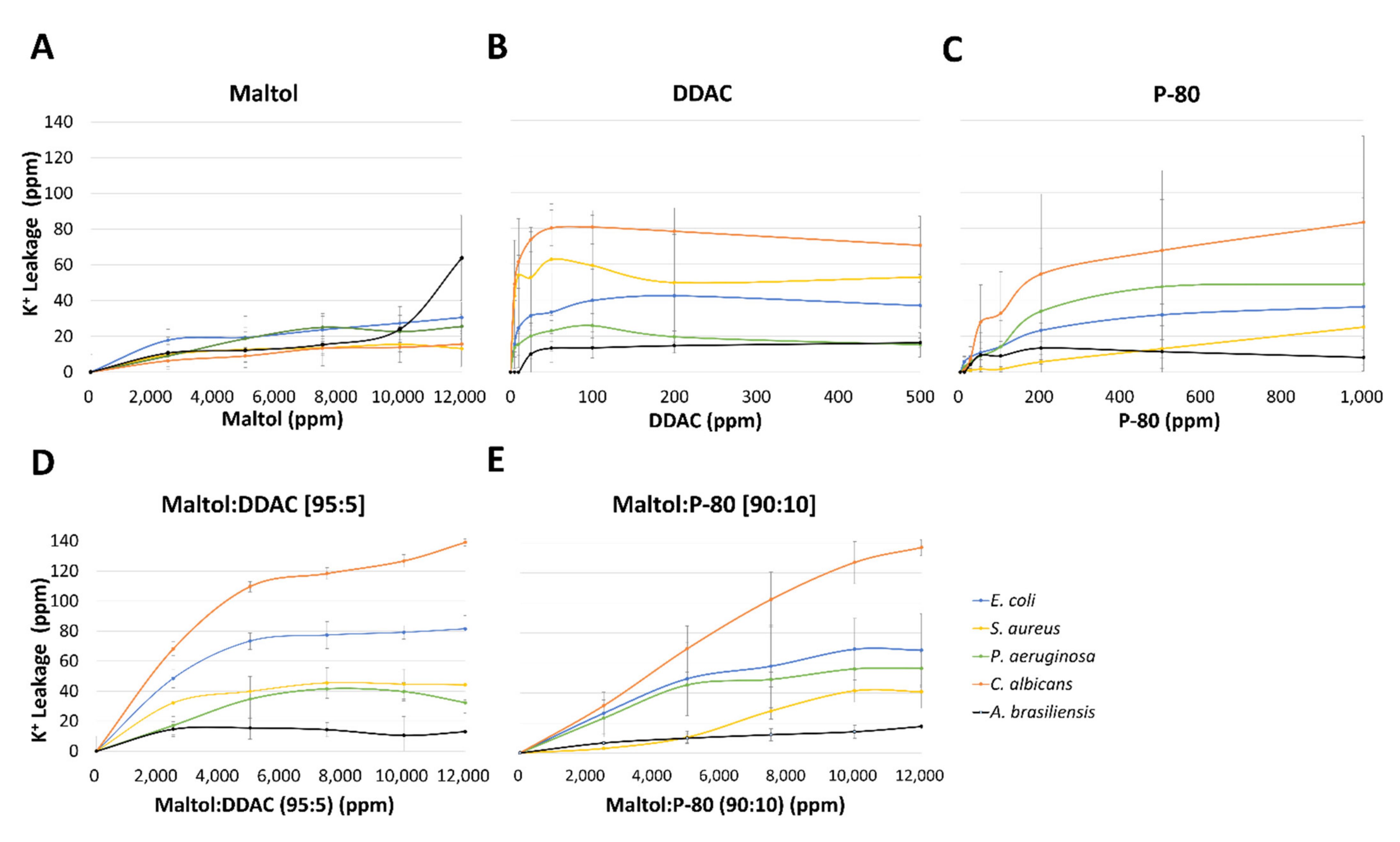
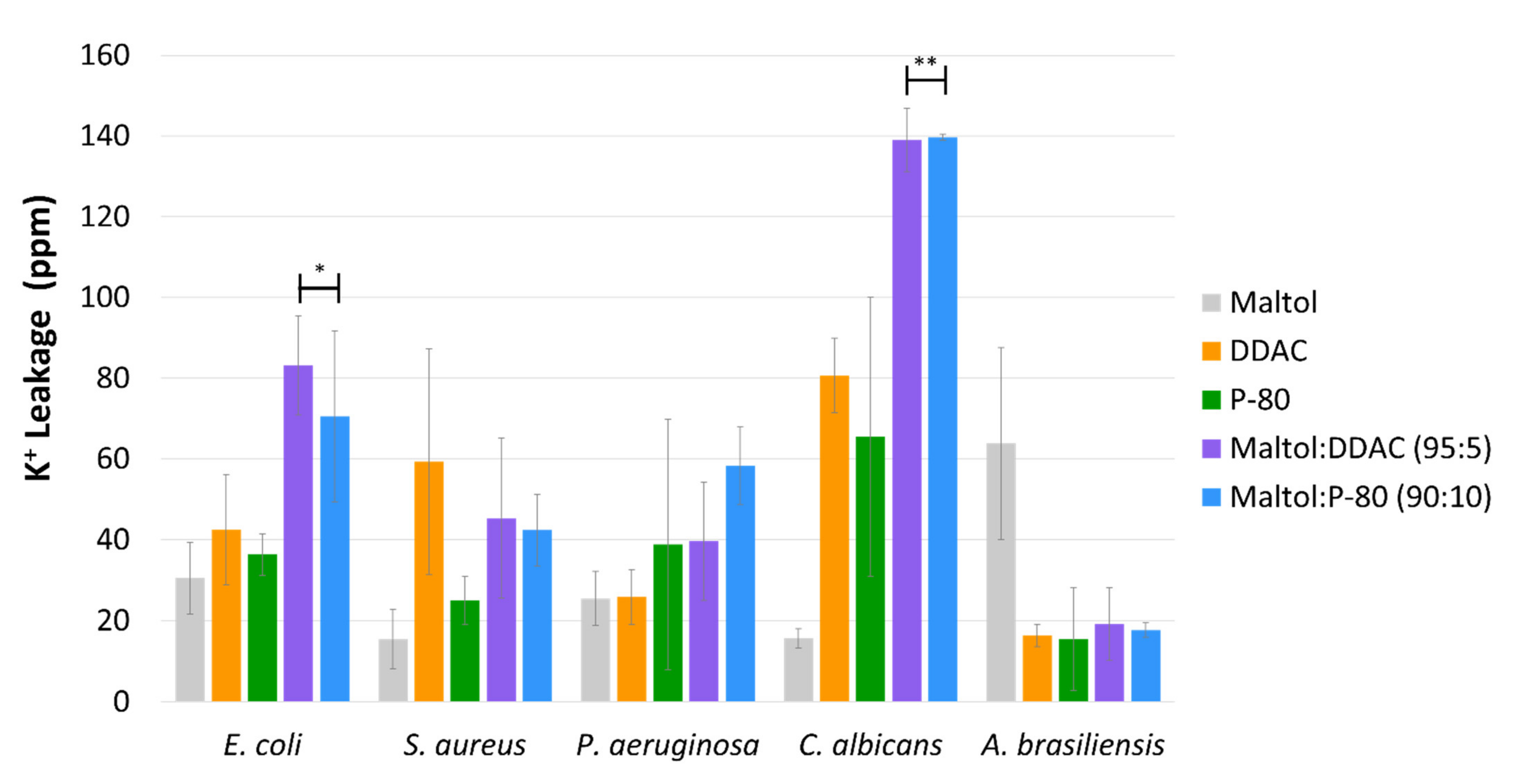
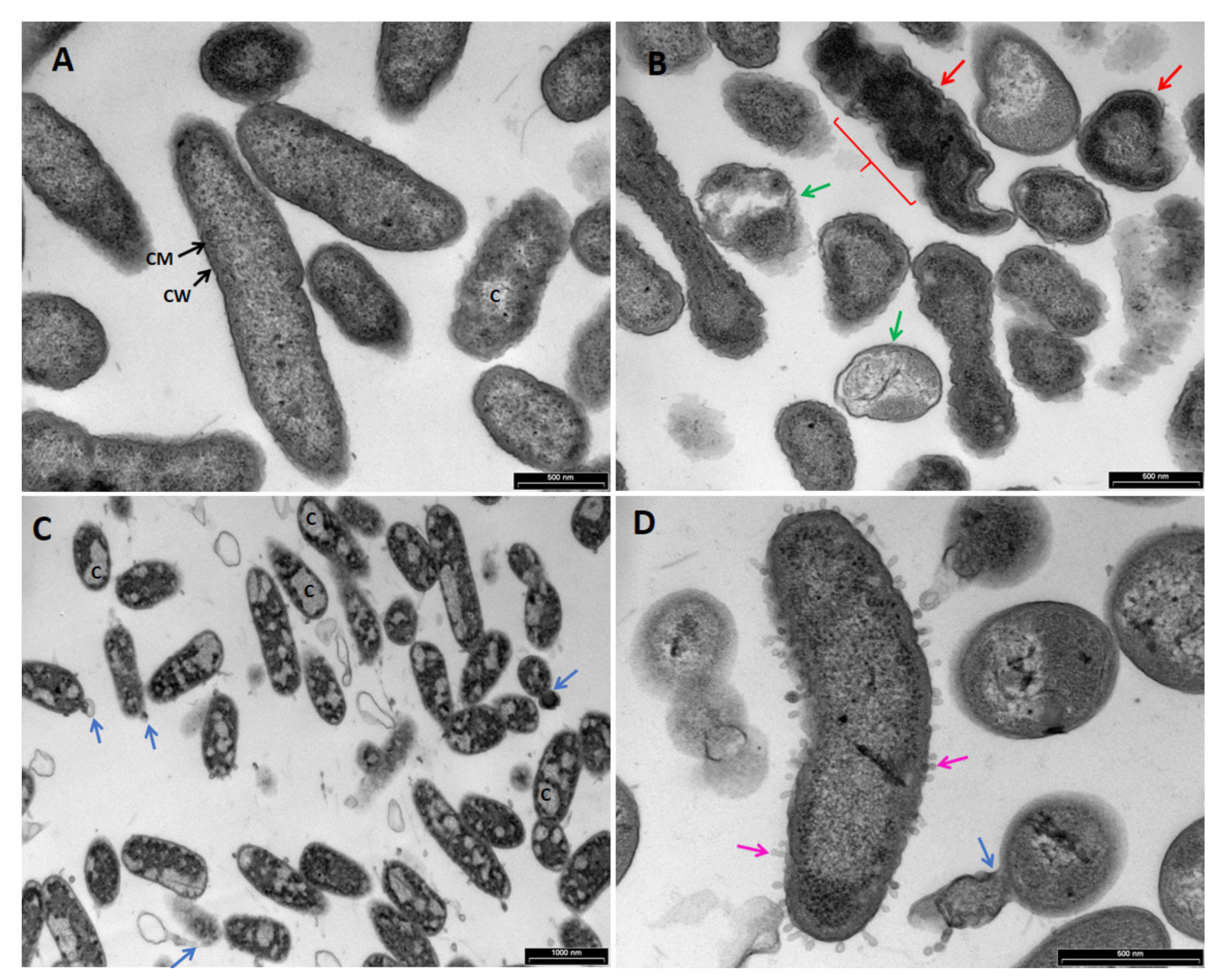

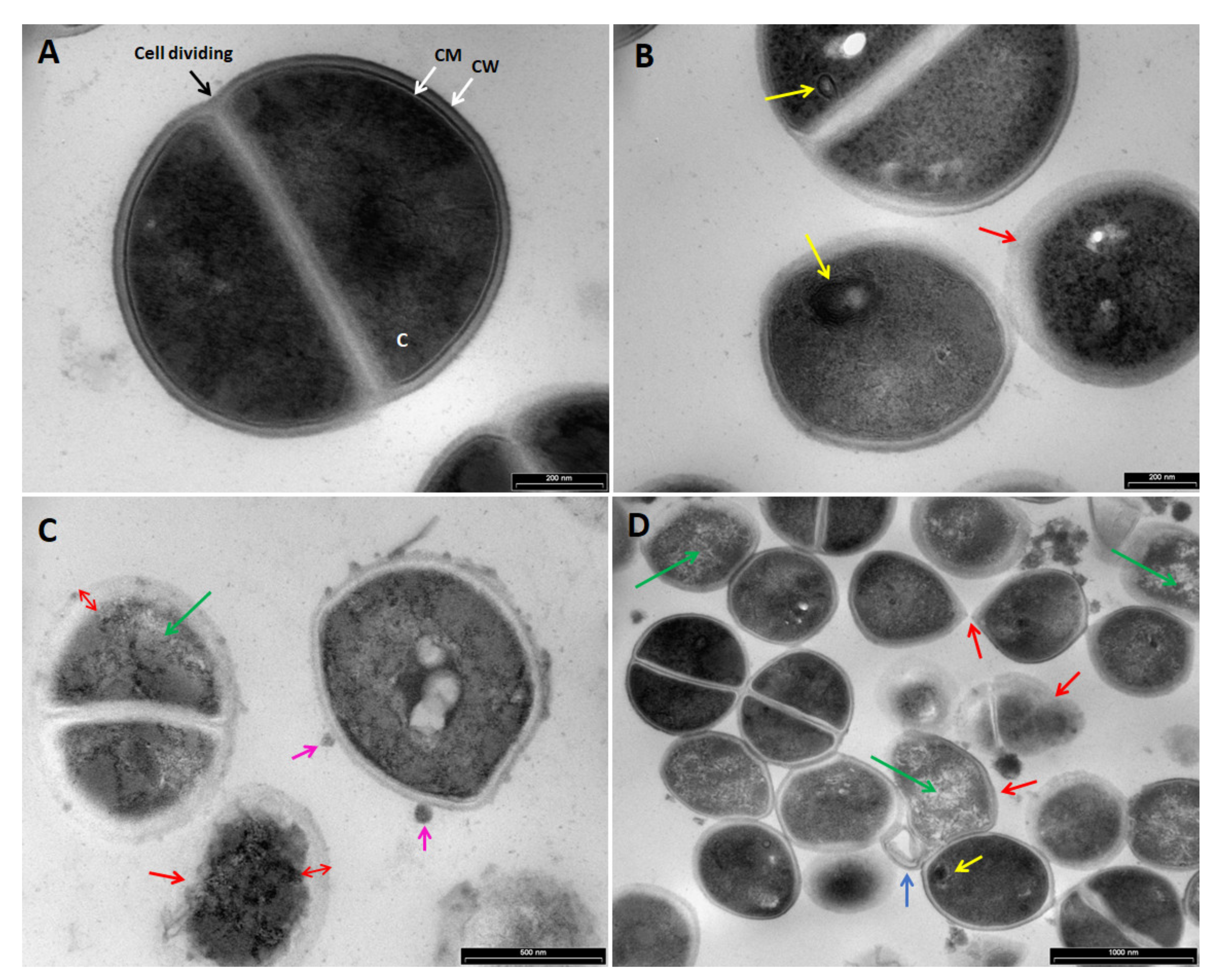
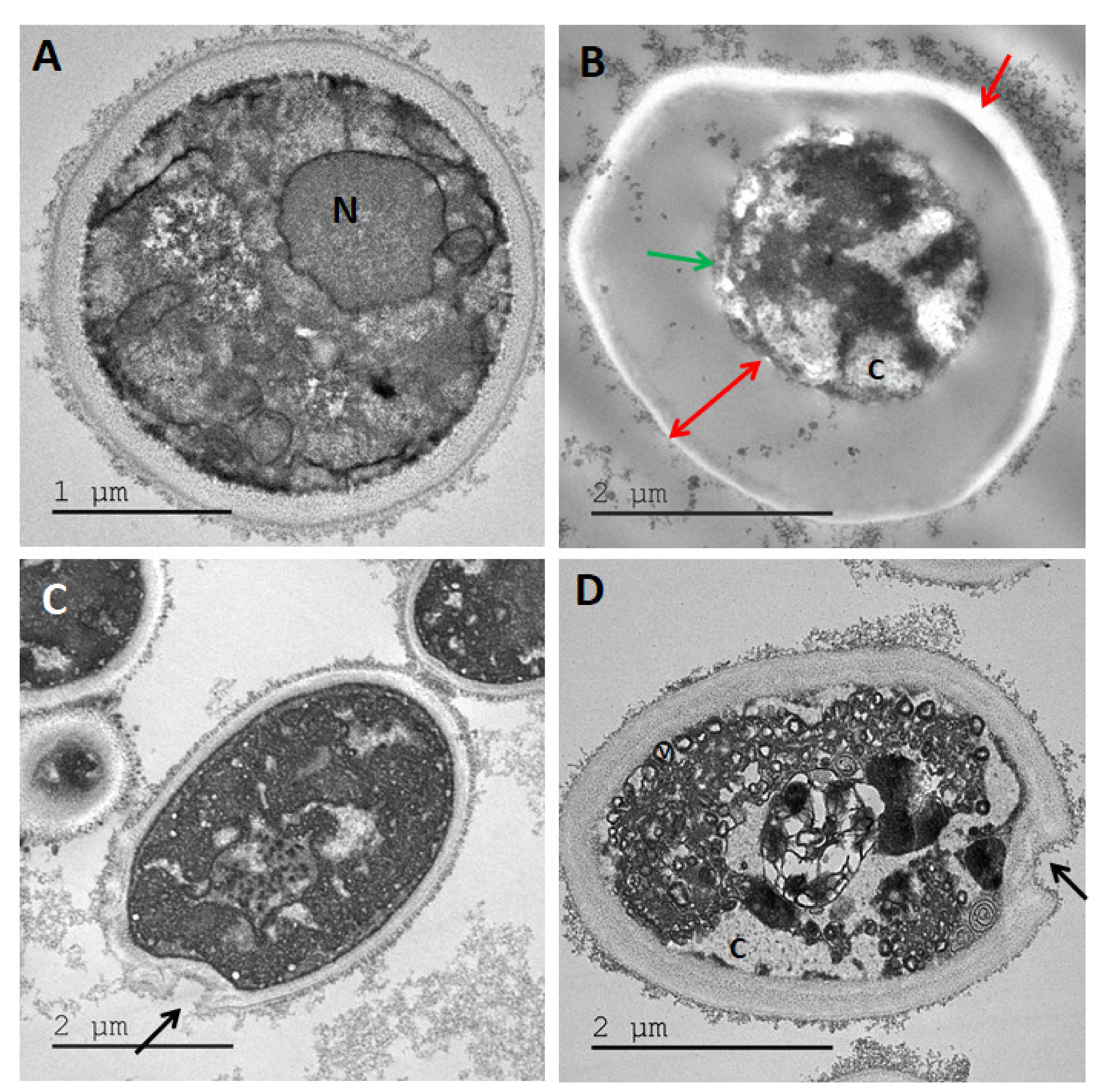
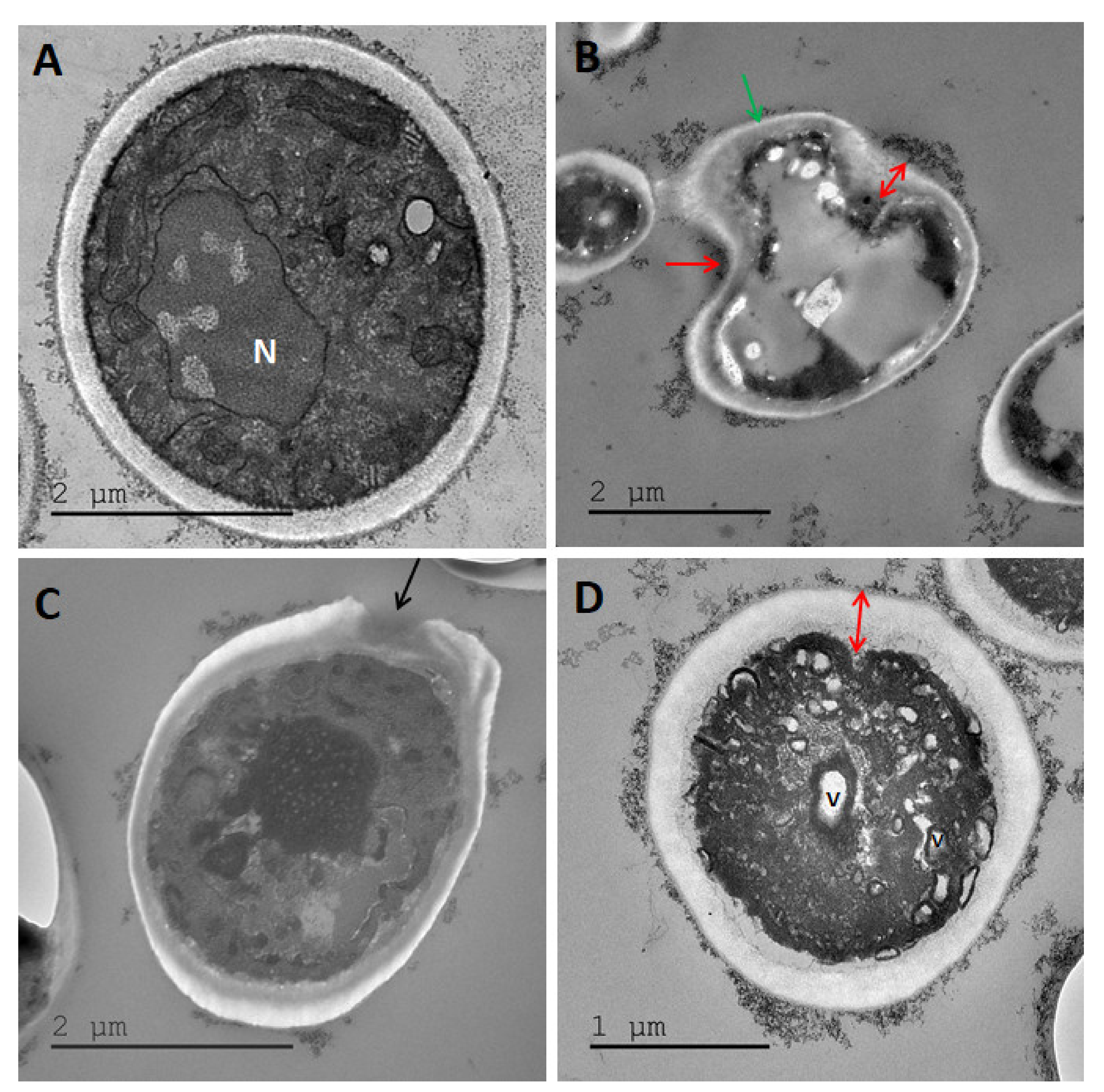
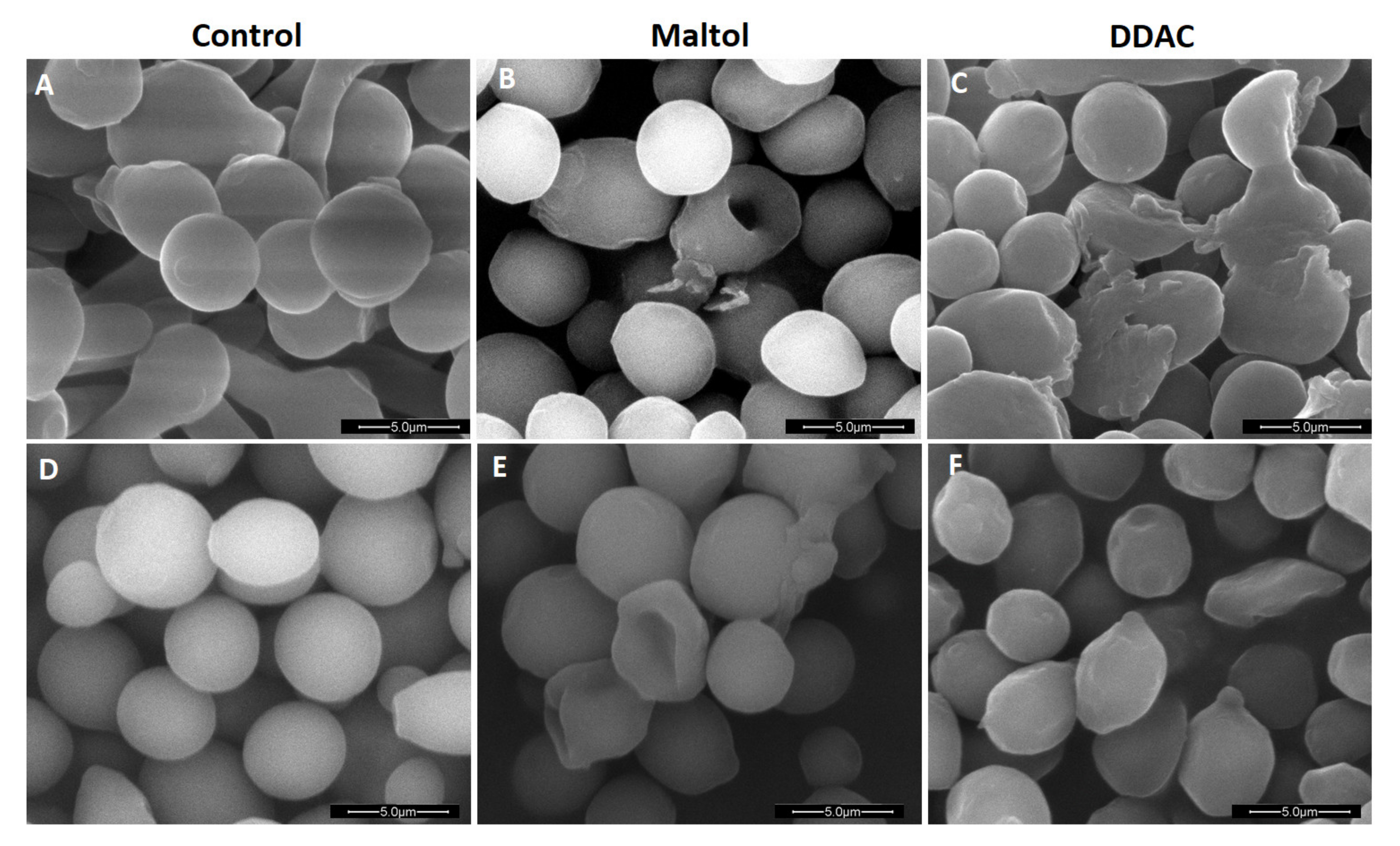
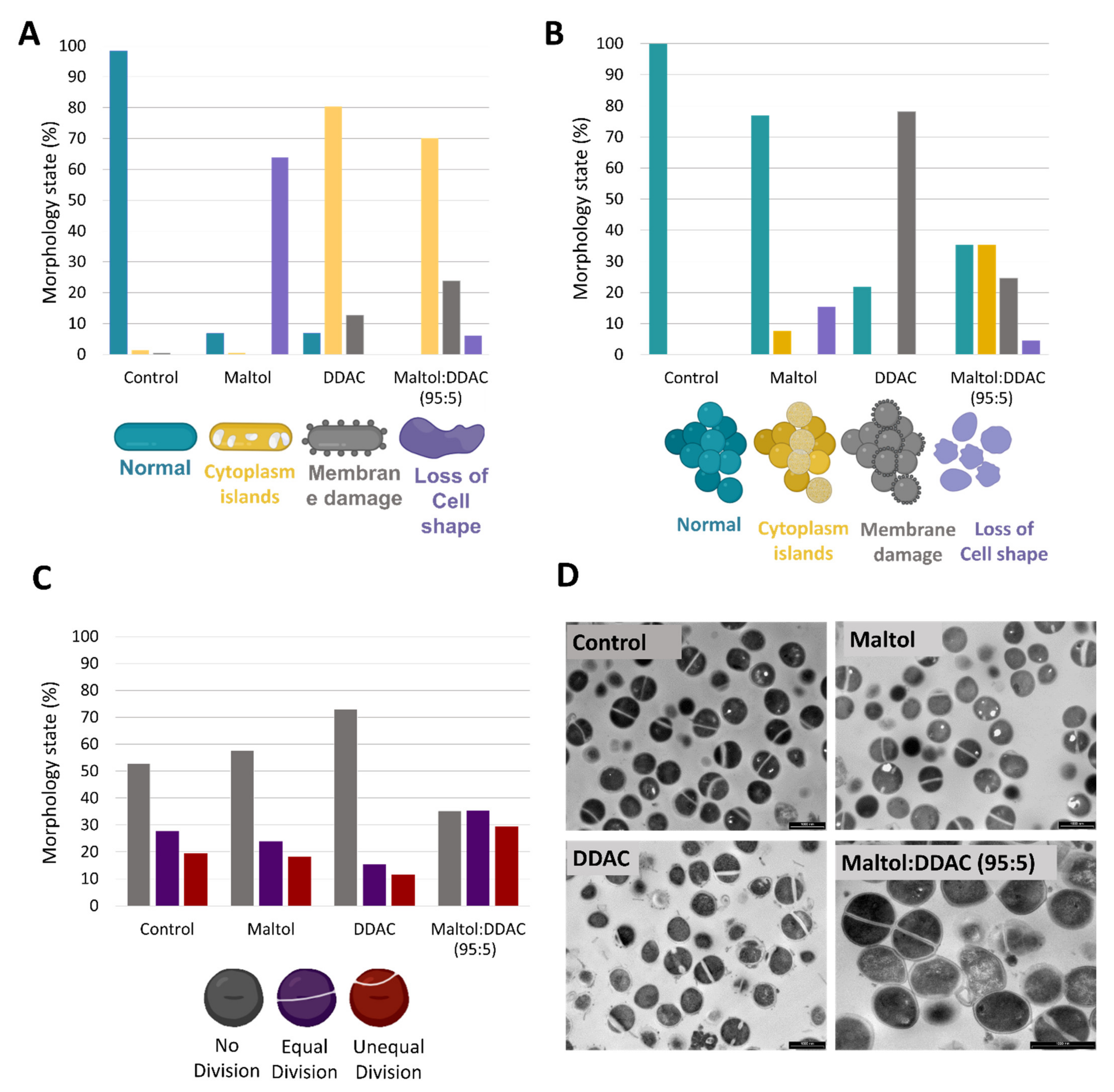
| Separate MIC100 (ppm) | Combined MIC100 (ppm) | Combined MIC100 (ppm) | |||||
|---|---|---|---|---|---|---|---|
| Maltol | DDAC | P80 | Maltol | DDAC | Maltol | P80 | |
| E. coli | 4000 | 3.12 | 250 | 250 | 0.78 | 500 | 31.25 |
| FICI = 0.31 | FICI = 0.25 | ||||||
| S. aureus | 4000 | 0.5 | 7.8 | 62.5 | 0.25 | 250 | 4 |
| FICI = 0.52 | FICI = 0.58 | ||||||
| P. aeruginosa | 1000 | 12.5 | 1000 | 62.5 | 6.25 | 250 | 62.5 |
| FICI = 0.56 | FICI = 0.31 | ||||||
| C. albicans | 2000 | 3.12 | 500 | 500 | 0.78 | 125 | 62.5 |
| FICI = 0.5 | FICI = 0.19 | ||||||
| A. brasiliensis | 4000 | 6.25 | 500 | 500 | 1.56 | 500 | 125 |
| FICI = 0.38 | FICI = 0.38 | ||||||
Publisher’s Note: MDPI stays neutral with regard to jurisdictional claims in published maps and institutional affiliations. |
© 2021 by the authors. Licensee MDPI, Basel, Switzerland. This article is an open access article distributed under the terms and conditions of the Creative Commons Attribution (CC BY) license (https://creativecommons.org/licenses/by/4.0/).
Share and Cite
Ziklo, N.; Bibi, M.; Salama, P. The Antimicrobial Mode of Action of Maltol and Its Synergistic Efficacy with Selected Cationic Surfactants. Cosmetics 2021, 8, 86. https://doi.org/10.3390/cosmetics8030086
Ziklo N, Bibi M, Salama P. The Antimicrobial Mode of Action of Maltol and Its Synergistic Efficacy with Selected Cationic Surfactants. Cosmetics. 2021; 8(3):86. https://doi.org/10.3390/cosmetics8030086
Chicago/Turabian StyleZiklo, Noa, Maayan Bibi, and Paul Salama. 2021. "The Antimicrobial Mode of Action of Maltol and Its Synergistic Efficacy with Selected Cationic Surfactants" Cosmetics 8, no. 3: 86. https://doi.org/10.3390/cosmetics8030086
APA StyleZiklo, N., Bibi, M., & Salama, P. (2021). The Antimicrobial Mode of Action of Maltol and Its Synergistic Efficacy with Selected Cationic Surfactants. Cosmetics, 8(3), 86. https://doi.org/10.3390/cosmetics8030086





